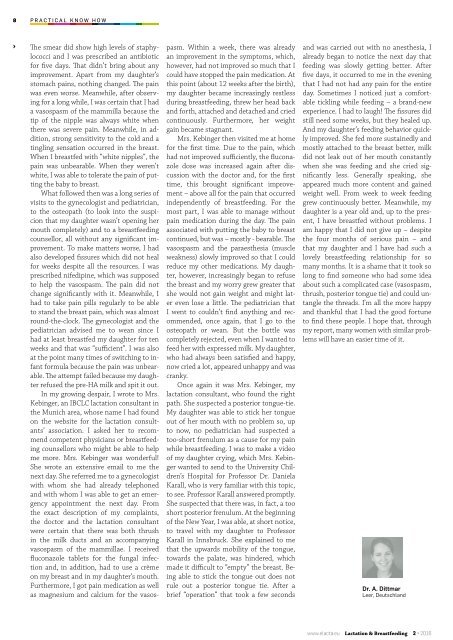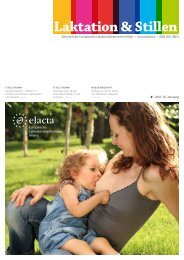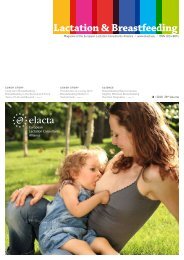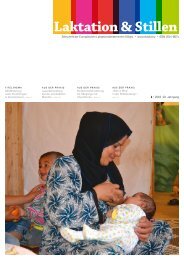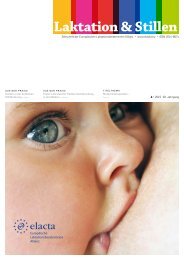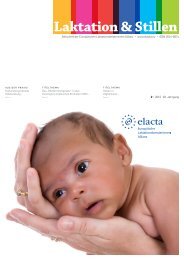Laktation_und_Stillen_2016-2 EN p1-8 web
You also want an ePaper? Increase the reach of your titles
YUMPU automatically turns print PDFs into web optimized ePapers that Google loves.
8<br />
PRACTICAL KNOW HOW<br />
›<br />
The smear did show high levels of staphylococci<br />
and I was prescribed an antibiotic<br />
for five days. That didn’t bring about any<br />
improvement. Apart from my daughter’s<br />
stomach pains, nothing changed. The pain<br />
was even worse. Meanwhile, after observing<br />
for a long while, I was certain that I had<br />
a vasospasm of the mammilla because the<br />
tip of the nipple was always white when<br />
there was severe pain. Meanwhile, in addition,<br />
strong sensitivity to the cold and a<br />
tingling sensation occurred in the breast.<br />
When I breastfed with “white nipples”, the<br />
pain was unbearable. When they weren’t<br />
white, I was able to tolerate the pain of putting<br />
the baby to breast.<br />
What followed then was a long series of<br />
visits to the gynecologist and pediatrician,<br />
to the osteopath (to look into the suspicion<br />
that my daughter wasn’t opening her<br />
mouth completely) and to a breastfeeding<br />
counsellor, all without any significant improvement.<br />
To make matters worse, I had<br />
also developed fissures which did not heal<br />
for weeks despite all the resources. I was<br />
prescribed nifedipine, which was supposed<br />
to help the vasospasm. The pain did not<br />
change significantly with it. Meanwhile, I<br />
had to take pain pills regularly to be able<br />
to stand the breast pain, which was almost<br />
ro<strong>und</strong>-the-clock. The gynecologist and the<br />
pediatrician advised me to wean since I<br />
had at least breastfed my daughter for ten<br />
weeks and that was “sufficient”. I was also<br />
at the point many times of switching to infant<br />
formula because the pain was unbearable.<br />
The attempt failed because my daughter<br />
refused the pre-HA milk and spit it out.<br />
In my growing despair, I wrote to Mrs.<br />
Kebinger, an IBCLC lactation consultant in<br />
the Munich area, whose name I had fo<strong>und</strong><br />
on the <strong>web</strong>site for the lactation consultants’<br />
association. I asked her to recommend<br />
competent physicians or breastfeeding<br />
counsellors who might be able to help<br />
me more. Mrs. Kebinger was wonderful!<br />
She wrote an extensive email to me the<br />
next day. She referred me to a gynecologist<br />
with whom she had already telephoned<br />
and with whom I was able to get an emergency<br />
appointment the next day. From<br />
the exact description of my complaints,<br />
the doctor and the lactation consultant<br />
were certain that there was both thrush<br />
in the milk ducts and an accompanying<br />
vasospasm of the mammillae. I received<br />
fluconazole tablets for the fungal infection<br />
and, in addition, had to use a crème<br />
on my breast and in my daughter’s mouth.<br />
Furthermore, I got pain medication as well<br />
as magnesium and calcium for the vasospasm.<br />
Within a week, there was already<br />
an improvement in the symptoms, which,<br />
however, had not improved so much that I<br />
could have stopped the pain medication. At<br />
this point (about 12 weeks after the birth),<br />
my daughter became increasingly restless<br />
during breastfeeding, threw her head back<br />
and forth, attached and detached and cried<br />
continuously. Furthermore, her weight<br />
gain became stagnant.<br />
Mrs. Kebinger then visited me at home<br />
for the first time. Due to the pain, which<br />
had not improved sufficiently, the fluconazole<br />
dose was increased again after discussion<br />
with the doctor and, for the first<br />
time, this brought significant improvement<br />
– above all for the pain that occurred<br />
independently of breastfeeding. For the<br />
most part, I was able to manage without<br />
pain medication during the day. The pain<br />
associated with putting the baby to breast<br />
continued, but was – mostly - bearable. The<br />
vasospasm and the paraesthesia (muscle<br />
weakness) slowly improved so that I could<br />
reduce my other medications. My daughter,<br />
however, increasingly began to refuse<br />
the breast and my worry grew greater that<br />
she would not gain weight and might later<br />
even lose a little. The pediatrician that<br />
I went to couldn’t find anything and recommended,<br />
once again, that I go to the<br />
osteopath or wean. But the bottle was<br />
completely rejected, even when I wanted to<br />
feed her with expressed milk. My daughter,<br />
who had always been satisfied and happy,<br />
now cried a lot, appeared unhappy and was<br />
cranky.<br />
Once again it was Mrs. Kebinger, my<br />
lactation consultant, who fo<strong>und</strong> the right<br />
path. She suspected a posterior tongue-tie.<br />
My daughter was able to stick her tongue<br />
out of her mouth with no problem so, up<br />
to now, no pediatrician had suspected a<br />
too-short frenulum as a cause for my pain<br />
while breastfeeding. I was to make a video<br />
of my daughter crying, which Mrs. Kebinger<br />
wanted to send to the University Children’s<br />
Hospital for Professor Dr. Daniela<br />
Karall, who is very familiar with this topic,<br />
to see. Professor Karall answered promptly.<br />
She suspected that there was, in fact, a too<br />
short posterior frenulum. At the beginning<br />
of the New Year, I was able, at short notice,<br />
to travel with my daughter to Professor<br />
Karall in Innsbruck. She explained to me<br />
that the upwards mobility of the tongue,<br />
towards the palate, was hindered, which<br />
made it difficult to “empty” the breast. Being<br />
able to stick the tongue out does not<br />
rule out a posterior tongue tie. After a<br />
brief “operation” that took a few seconds<br />
and was carried out with no anesthesia, I<br />
already began to notice the next day that<br />
feeding was slowly getting better. After<br />
five days, it occurred to me in the evening<br />
that I had not had any pain for the entire<br />
day. Sometimes I noticed just a comfortable<br />
tickling while feeding – a brand-new<br />
experience. I had to laugh! The fissures did<br />
still need some weeks, but they healed up.<br />
And my daughter’s feeding behavior quickly<br />
improved. She fed more sustainedly and<br />
mostly attached to the breast better, milk<br />
did not leak out of her mouth constantly<br />
when she was feeding and she cried significantly<br />
less. Generally speaking, she<br />
appeared much more content and gained<br />
weight well. From week to week feeding<br />
grew continuously better. Meanwhile, my<br />
daughter is a year old and, up to the present,<br />
I have breastfed without problems. I<br />
am happy that I did not give up – despite<br />
the four months of serious pain – and<br />
that my daughter and I have had such a<br />
lovely breastfeeding relationship for so<br />
many months. It is a shame that it took so<br />
long to find someone who had some idea<br />
about such a complicated case (vasospasm,<br />
thrush, posterior tongue tie) and could untangle<br />
the threads. I’m all the more happy<br />
and thankful that I had the good fortune<br />
to find these people. I hope that, through<br />
my report, many women with similar problems<br />
will have an easier time of it.<br />
Dr. A. Dittmar<br />
Leer, Deutschland<br />
www.elacta.eu Lactation & Breastfeeding 2 • <strong>2016</strong>


